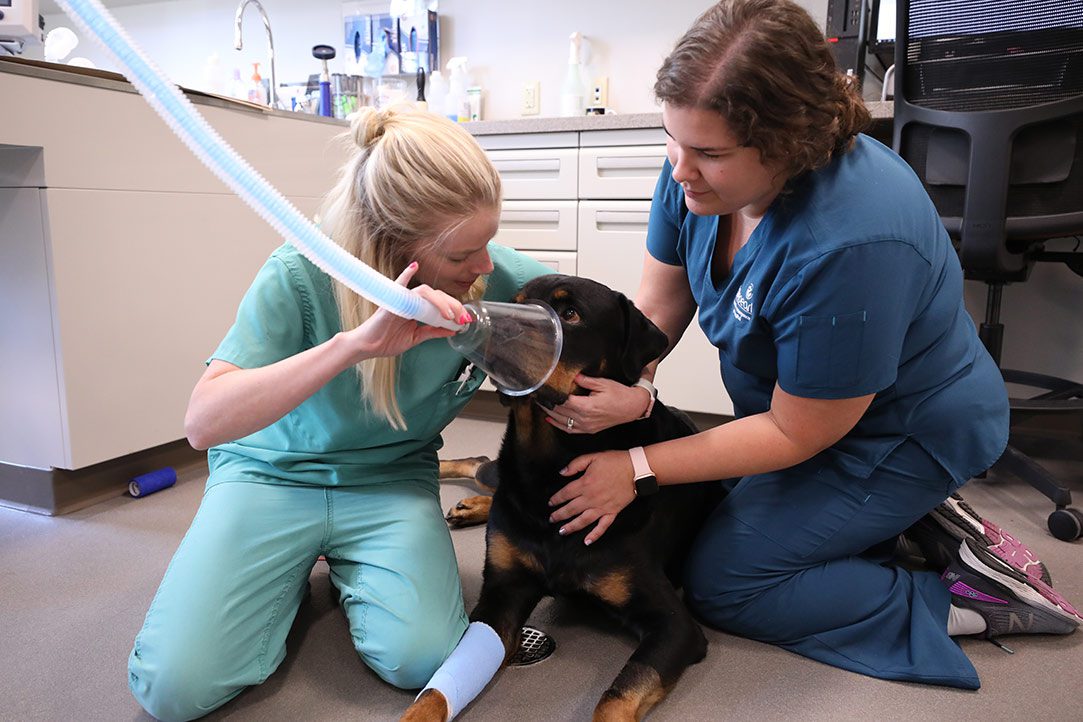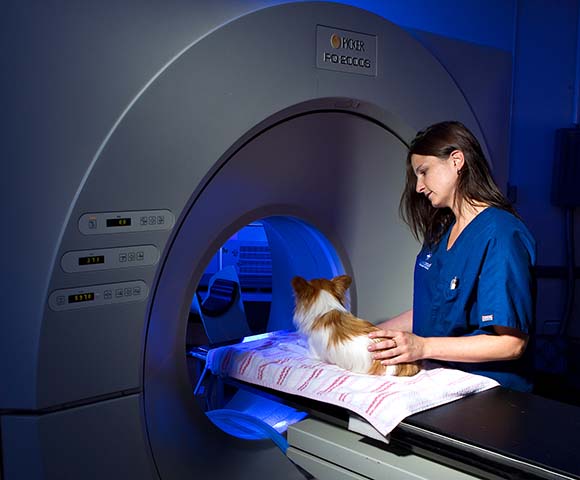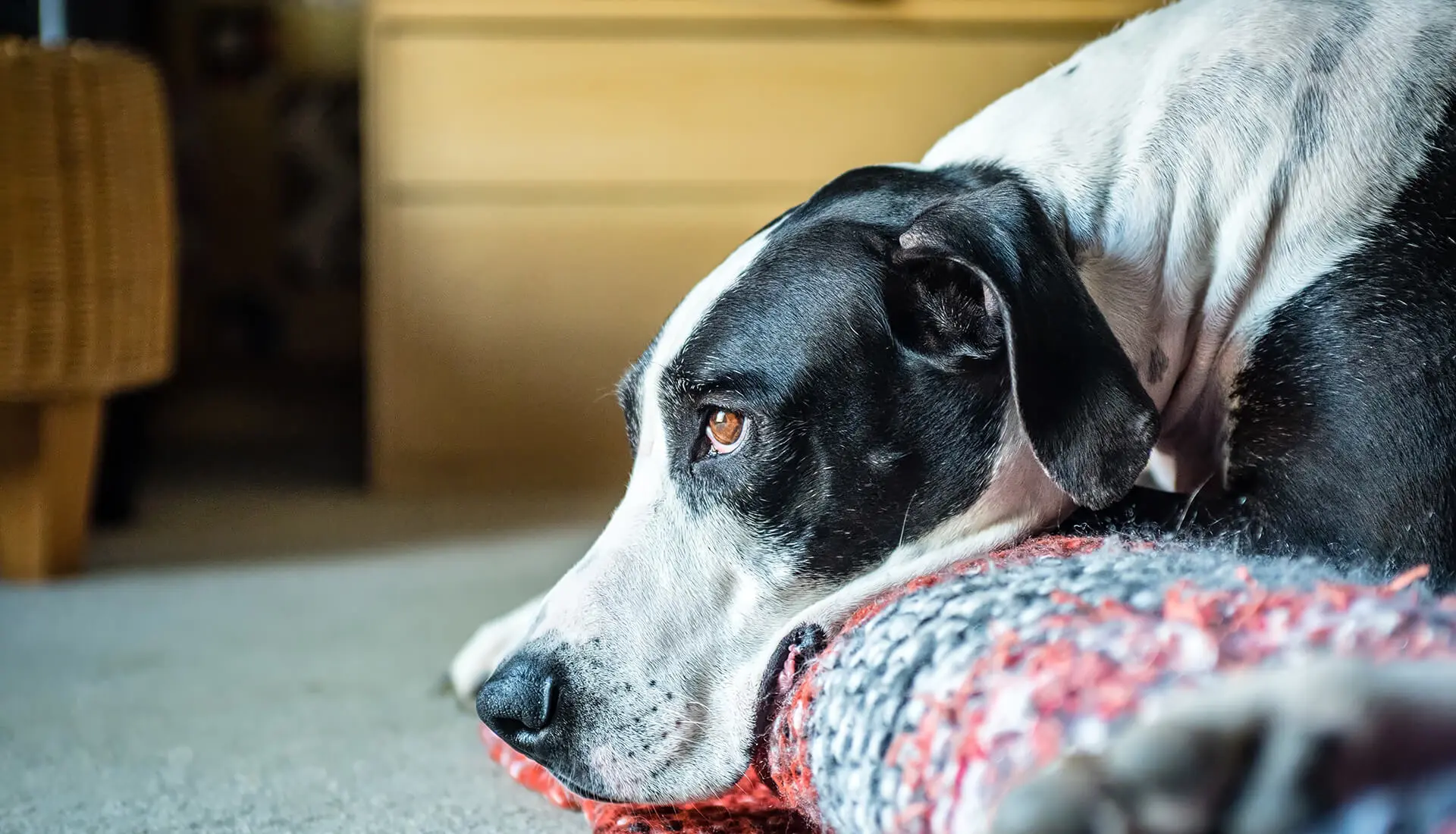What is pneumonia?
Pneumonia is defined as inflammation or infection of the lungs, which can lead to variable signs of illness and sometimes difficulty breathing. Pneumonia in dogs and cats can be primary (infectious pneumonia) or secondary (to another predisposing condition).
 In general, dogs develop pneumonia much more commonly than cats, and pneumonia secondary to another cause is much more common than primary pneumonia. Depending on the amount of lung tissue affected, the cause, and the patient’s overall health status, pneumonia may have a spectrum of illness severity and outcomes. Some patients can be treated on an outpatient basis with oral medications, while others may require oxygen support in a hospital setting.
In general, dogs develop pneumonia much more commonly than cats, and pneumonia secondary to another cause is much more common than primary pneumonia. Depending on the amount of lung tissue affected, the cause, and the patient’s overall health status, pneumonia may have a spectrum of illness severity and outcomes. Some patients can be treated on an outpatient basis with oral medications, while others may require oxygen support in a hospital setting.
Pneumonia can quickly progress to respiratory distress, so contacting a veterinarian or emergency hospital is important if pneumonia is suspected.
Clinical signs and symptoms.
Clinical signs of pneumonia in dogs and cats depend on the disease’s cause, severity and longevity.
Mild cases in the early stages may have an intermittent soft cough or mild exercise intolerance.
More severe acute cases can have a productive cough, increased breathing rate, fever, nasal flaring, inability to lay down or rest, and systemic signs of illness such as lethargy and lack of appetite.
In very severe cases, patients may have abnormal breathing postures and a blue discoloration of the tongue or gums (cyanosis), which is life-threatening.
Causes.
Dogs are more likely than cats to develop pneumonia and usually do so due to another underlying condition. Aspiration of orogastric contents (such as after regurgitation or vomiting) is the most common cause of pneumonia in dogs. Dogs that swim or play in water also have a risk of aspirating salt or freshwater contents. Undergoing general anesthesia can also predispose dogs to aspiration pneumonia. Some dogs can develop progressive neurologic dysfunction that affects the larynx (laryngeal paralysis), which can also hinder their ability to protect the airway.
Dogs and cats can also acquire pneumonia through infection with a respiratory virus or bacteria such as Bordetella bronchiseptica. Canine infectious respiratory disease complex (CIRDC, formerly called kennel cough) consists of several transmissible viral and bacterial infections. It is prevalent in stressed and overcrowded conditions where many dogs interact, such as shelters, daycare or boarding facilities, puppy stores, breeding facilities, and dog park enclosures. Infectious pneumonia usually develops within a few days and up to 1-2 weeks after exposure, depending on the incubation period of the infection. Even a mild viral upper respiratory infection can weaken the immune system and allow bacterial pneumonia to settle in.
Cats rarely develop aspiration and infectious pneumonia, though cases certainly exist. Much more common causes of respiratory distress in cats are heart failure resulting in fluid build-up around or inside the lungs or feline asthma, which typically has a long-standing chronic course with intermittent flare-ups of coughing and respiratory distress.
Getting a diagnosis.
Chest radiographs (x-rays) are imperative for diagnosis of pneumonia. These may be performed by a primary care veterinarian or an emergency room veterinarian. It is recommended to consult a board-certified radiologist for interpretation for two main reasons: 1) Sometimes lung changes are subtle and can be missed, and 2) many diseases look alike, and dogs and cats have more lung lobes than people.
The location of the abnormalities and evaluation of all the structures on the radiograph are key to prioritizing the type of pneumonia, a potential underlying cause (such as esophageal dilation), or to differentiate infectious multi-lobar pneumonia from heart failure. Several BluePearl hospitals have on-site radiologists and all BluePearl hospitals have tele-radiology services in order to be able to provide this service to clients.
Additional tests that can help to determine how sick the pet is may include:
- Complete blood count to evaluate white blood cell counts (and all cell lines)
- Biochemistry profile to evaluate organ function, hydration and electrolytes
- Respiratory disease PCR test – a simple swab of oral, ocular or nasal secretions submitted to a diagnostic lab to screen for infectious diseases (may take 5-7 days for results)
- Pulse oximetry to evaluate the oxygen levels in the bloodstream
- Blood pressure
Some cases of pneumonia, such as those with recurrence or lack of improvement, benefit from advanced diagnostics such as tracheoscopy and bronchoscopy with lower airway sampling of secretions (called broncho-alveolar lavage or BAL). These samples are then sent to a lab for cytology and microbiology (including antibiotic sensitivity patterns). This is performed under general anesthesia and ideally with a stable patient in a planned, procedural fashion.
 Other cases may benefit from thoracic CTs (computed tomography, a type of advanced cross-sectional imaging that offers detailed three-dimensional imaging of the entire chest). This can help patients who may have an inhaled foreign body into a lung lobe or the potential for lung masses or abscesses within a lung lobe suspected of having pneumonia. This procedure is also performed under general anesthesia, allowing the lungs to be inflated at specific times, and contrast agents to be injected intravenously to further optimize imaging.
Other cases may benefit from thoracic CTs (computed tomography, a type of advanced cross-sectional imaging that offers detailed three-dimensional imaging of the entire chest). This can help patients who may have an inhaled foreign body into a lung lobe or the potential for lung masses or abscesses within a lung lobe suspected of having pneumonia. This procedure is also performed under general anesthesia, allowing the lungs to be inflated at specific times, and contrast agents to be injected intravenously to further optimize imaging.
BluePearl’s internal medicine specialists are specifically trained in performing bronchoscopy, BALs, and CT scans. This can then provide specific direction in treatment protocols in these more advanced cases.
Treatment.
Appropriate treatment of pneumonia in dogs and cats usually involves antibiotics. Because antibiotic resistance has been found in up to 25% of empirically treated cases, some hospitals may recommend obtaining airway samples for bacterial culture and sensitivity, especially if pneumonia treatment fails the first time or recurs for an unknown reason.
Most uncomplicated bacterial cases of pneumonia respond to a course of antibiotics, usually two weeks in length. Veterinarians may reference the International Society for Companion Animal Infectious Disease (ISCAID) published guidelines for the treatment of dogs and cats with respiratory infections.
It is important to document clearance of the pneumonia with repeat radiographs (x-rays) because the pet may improve significantly but the disease is not fully cleared. In those cases, antibiotics should be extended until radiographs show normal lungs.
Patients with more severe signs of difficulty breathing, low oxygenation, fever or dehydration usually must be hospitalized for oxygen support, IV fluids, IV antibiotics and general supportive care.
In many cases, improvement is seen in 2-3 days and the pet can then be discharged to continued home care with planned rechecks.
In more complex cases, patients may require advanced oxygen support such as high-flow oxygen therapy (HFOT) or even mechanical ventilation. Many BluePearl hospitals with critical care specialists offer these advanced therapies.
If there is concern that a pet with pneumonia is declining and may need advanced oxygen support, they should be transported to the most advanced local facility (such as a specialty hospital or university hospital) as early as possible since patients with worsening respiratory distress quickly become unstable for transport, especially where long distances are involved.
Prevention.
Vaccination is imperative to decrease the risk of infectious pneumonia or its severity if the pet acquires an infection. Many boarding and daycare facilities require proof of current vaccination for this reason. Primary care veterinarians can recommend core vaccines. In some cases, non-core vaccination (such as for canine influenza) may also be appropriate, as there are outbreaks of this virus periodically around the United States.

Even in vaccinated pets, the “kennel cough” complex contains organisms for which a vaccine does not exist, so there is still a risk for infection. Therefore, vaccinated pets who develop respiratory signs should be seen by a veterinarian to determine if upper or lower airways are involved and if specific treatment is warranted before the condition progresses.
Aspiration pneumonia is one of the most common causes of secondary pneumonia in dogs, and preventing the cause is key. If a pet is vomiting or regurgitating, they should be seen by a veterinarian to determine the cause of the gastrointestinal signs and to be evaluated for pneumonia. Brachycephalic breeds (such as French bulldogs, American bulldogs, Boston terriers, etc.) are predisposed to both regurgitation or vomiting and aspiration pneumonia.
Prognosis.
Dogs and cats can develop pneumonia for several reasons. Identifying and addressing predisposing conditions can help prevent pneumonia from worsening or recurring. The prognosis for pneumonia depends on the severity of the disease, the animal’s overall health status, and the organism’s ability to cause damage.
Overall, most hospitalized patients with uncomplicated pneumonia are discharged to home care and make a full recovery.


